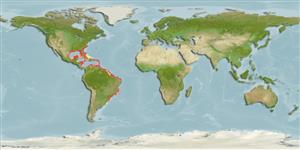Common names from other countries
Environment: milieu / climate zone / depth range / distribution range
Ecología
marino asociado a arrecife; rango de profundidad 10 - 140 m (Ref. 7251), usually 10 - 90 m (Ref. 5217). Tropical; 37°N - 34°S, 98°W - 34°W
Western Atlantic: North Carolina, USA and northern Gulf of Mexico to Brazil. Eastern Atlantic: Ascension Island (Ref. 26340).
Length at first maturity / Tamaño / Peso / Age
Maturity: Lm ?, range 10 - ? cm
Max length : 30.0 cm TL macho / no sexado; (Ref. 7251); common length : 20.0 cm TL macho / no sexado; (Ref. 5217)
Espinas dorsales (total) : 0; Radios blandos dorsales (total) : 79 - 94; Espinas anales: 0; Radios blandos anales: 63 - 75. In males, the 1st and 2nd rays of the pectoral fin become filamentous (Ref. 35237).
Predator which lives on the bottom where it hides partially or almost completely in the sand in order to disguise itself in the environment. Feeds on small fish and invertebrates. Exhibits sexual dimorphism (Ref. 35237). Marketed fresh (Ref. 5217).
Life cycle and mating behavior
Maturities | Reproducción | Spawnings | Egg(s) | Fecundities | Larva
Oviparous (Ref. 101737). Distinct pairing (Ref. 205). Females produce numerous eggs in multiple spawnings during a prolonged spawning period (Ref. 101737).
Robins, C.R. and G.C. Ray, 1986. A field guide to Atlantic coast fishes of North America. Houghton Mifflin Company, Boston, U.S.A. 354 p. (Ref. 7251)
IUCN Red List Status (Ref. 130435)
CITES (Ref. 128078)
Not Evaluated
Threat to humans
Harmless
Human uses
Pesquerías: escaso valor comercial
Herramientas
Special reports
Download XML
Fuentes de Internet
Estimates based on models
Preferred temperature (Ref.
115969): 21.4 - 27.9, mean 25.6 (based on 874 cells).
Phylogenetic diversity index (Ref.
82804): PD
50 = 0.5039 [Uniqueness, from 0.5 = low to 2.0 = high].
Bayesian length-weight: a=0.00776 (0.00581 - 0.01037), b=3.07 (3.01 - 3.13), in cm Total Length, based on LWR estimates for this species (Ref.
93245).
Nivel trófico (Ref.
69278): 3.6 ±0.0 se; based on diet studies.
Resiliencia (Ref.
120179): Alto, población duplicada en un tiempo mínimo inferior a 15 meses (Preliminary K or Fecundity.).
Fishing Vulnerability (Ref.
59153): Low vulnerability (20 of 100).
